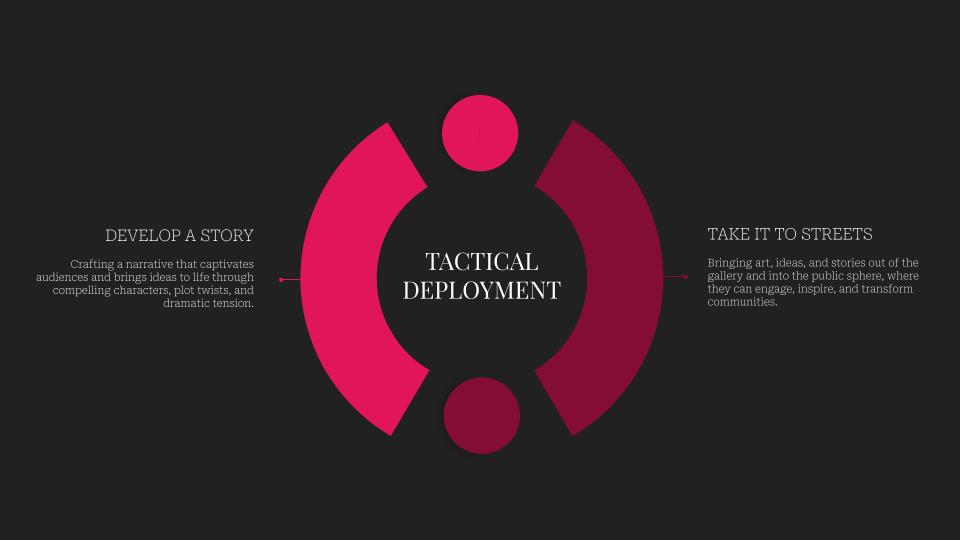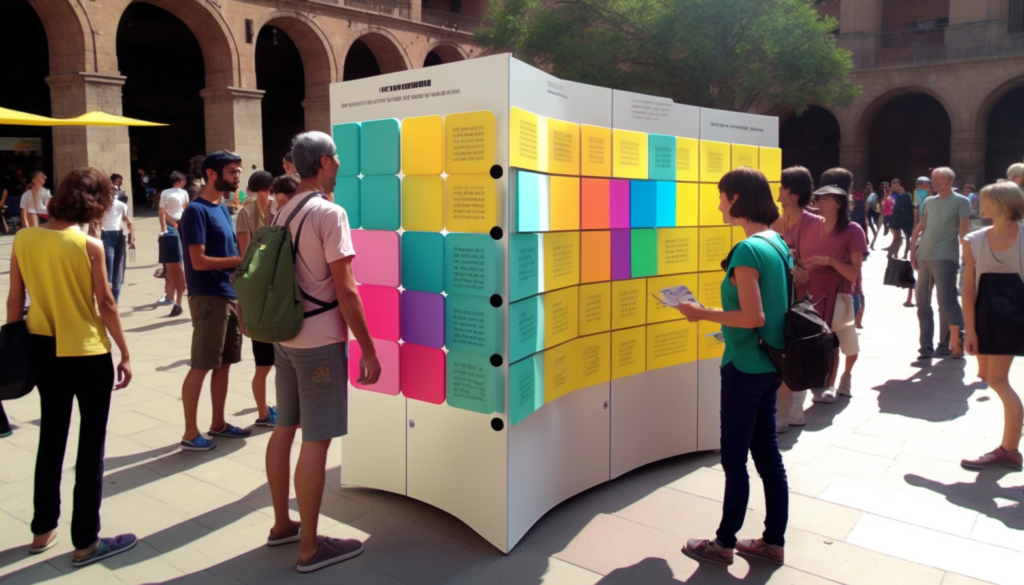INTRODUCTION
Interactive design is a rapidly evolving field that has the potential to revolutionize the way we experience and interact with art and information. With advancements in technology, visual and multimedia artists now have the ability to create immersive and interactive exhibitions that engage the viewer on a whole new level. This changing state of art is shifting from something static to something dynamic, and the possibilities are endless.
CONCEPT: STORYTELLING

Storytelling is a powerful tool that can transport viewers to new worlds and challenge their perspectives. But what happens when we take this narrative beyond the walls of the gallery or museum? Taking art to the streets means bringing these stories and ideas directly to the people, where they can engage, inspire, and transform communities. By taking art out of its traditional context, we create a unique and accessible experience that breaks down barriers and fosters a sense of connection and belonging.

The vision for this project is to take interactive art experiences to the streets through tactical deployment. By utilizing public spaces, such as parks, roads, or public squares, we can create an immersive and dynamic experience that encourages participation and engagement. By leveraging technology and creative design, we can create an experience that is both engaging and accessible, inviting people from all walks of life to participate and contribute.
A. RECIPROCAL INFORMATION EXCHANGE

To work around Superblocks and develop a template for an interactive exhibition, we first conducted extensive research to gain a deep understanding of the concept and its potential benefits. We then identified the key elements of the Superblocks concept and developed a clear and concise visual representation of the idea using line drawings and illustrations.
Next, we created an interactive exhibition that allowed viewers to engage with the Superblocks concept in a meaningful way. We used a combination of projections, audio, and visual elements to create an immersive experience that allowed viewers to see the Superblocks concept in action and understand how it could impact their city.
To make the exhibition truly interactive, we included elements that allowed viewers to provide feedback and share their thoughts and ideas about the Superblocks concept. This two-way exchange of information helped to create a more collaborative and dynamic art experience, allowing the artists to improve their work and better understand the needs and desires of their audience.

Overall, our approach to working around the concept of Superblocks and developing a template for an interactive exhibition involved a combination of research, clear visual representation, immersive experience, and a two-way exchange of information. This approach allowed us to effectively communicate the benefits and potential of the Superblocks concept to a wider audience and create a shared experience that was both personal and collective.
B. ARTWORK
The visual expression of Barcelona’s vision for Superblocks was developed through a combination of line drawings and illustrations in coherence with projection. The process involved creating an interactive exhibition that allowed viewers to engage with the concept of Superblocks and provide valuable feedback for the artists. The interactive nature of the exhibition allowed for a two-way exchange of information, which led to a deeper understanding of the concept and valuable data for the artists to improve their work.
The use of line drawings and illustrations helped to create a clear and concise representation of Barcelona’s vision for Superblocks, making it easy for viewers to understand and engage with the concept. The projections added an additional layer of interactivity and engagement, allowing viewers to see the Superblocks concept in action and visualize how it could impact their city.
Through this visual expression, the artists were able to effectively communicate the benefits and potential of the Superblocks concept to a wider audience. The use of interactive design allowed for a more dynamic and engaging art experience, creating a shared experience that was both personal and collective. Overall, the development of this visual expression was a critical part of the project, helping to bring the concept of Superblocks to life and engage viewers in a meaningful way.
C. INTERACTION
In this project, the use of interaction was a critical element in creating an immersive and engaging art experience. We chose to use a tangible user interface (TUI) approach to interaction, which involved a guided interaction by touch. This approach allowed viewers to physically interact with the exhibition and provide valuable feedback through touch and manipulation of the interactive elements.
The TUI approach allowed us to create a more intuitive and natural interaction, which was easy for viewers to understand and engage with. By providing a guided interaction, we were able to ensure that viewers had a clear understanding of the Superblocks concept and how it could impact their city. This approach also allowed us to collect valuable data and feedback from viewers, which was used to improve the exhibition and enhance the overall art experience.

The capacity board connected with Arduino played a crucial role in actualizing this design by providing a seamless and efficient way to measure and monitor user interaction with the installation. The capacity board is a versatile tool that can measure various inputs such as proximity, touch, and sound, allowing for a wide range of interactions to be captured and processed. With the help of Arduino, this data can then be translated into actionable insights that can be used to fine-tune the installation and make it more engaging and interactive for users.
The ability to capture and analyze user data in real time has also allowed for more dynamic and responsive interactions. With the capacity board and Arduino, the installation can adapt to user behavior, triggering different responses based on the level and type of engagement. This not only enhances the user experience but also creates a more personalized and memorable interaction.
Moreover, the flexibility of Arduino has enabled the design to be deployed in various locations throughout the city, enabling the installation to take art out of the gallery and into the public sphere. With the capacity board and Arduino, the installation can be easily transported and set up in different locations, providing new and exciting experiences for different communities. The result is a design that is not only visually stunning but also highly interactive and adaptable, thanks to the integration of the capacity board and Arduino technology.

In this project, the use of conductive tape was a critical element in creating a flexible and adaptable interactive exhibition. Conductive tape allowed us to create electrical connections between different components of the exhibition, without the need for permanent connections such as soldering. This meant that we could easily modify and adjust the design as needed, without causing damage to the exhibition or the components used.
The conductive tape also allowed us to create more intricate and complex designs, which would have been challenging to achieve with traditional wiring methods. We were able to create a more seamless and aesthetically pleasing design, which was an important element in creating an immersive and engaging art experience.
Overall, the use of conductive tape allowed us to create a flexible and adaptable interactive exhibition that was easy to modify and adjust as needed. It also allowed us to create more intricate and complex designs, which contributed to the overall aesthetic and art experience. The use of conductive tape was a critical element in the success of the project, and it highlighted the importance of using innovative and flexible methods to achieve the desired outcome in interactive design.
TACTICAL DEPLOYMENT
In conclusion, the tactical deployment of interactive art and exhibitions through the use of innovative technologies such as conductive tape and tangible user interface has opened up new avenues for artistic expression and engagement. With the success of this project, it is clear that interactive design has the potential to transform the traditional art experience into something more dynamic, engaging, and immersive. The use of interactive exhibitions also provides valuable data and feedback for artists to improve their work, leading to a more collaborative and innovative art experience. We envision a future where interactive exhibitions are commonplace across Barcelona, providing a platform for innovation, growth, and engagement in the field of art. With the continued advancement of technology, the possibilities for interactive art experiences are endless, and we look forward to the continued evolution of interactive design in the years to come.



